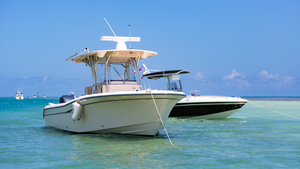What Size Anchor Do I Need?
Choosing the right anchor size for your boat is crucial for ensuring stability and safety while out on the water. Understanding the importance of anchor size and the factors that determine it is essential for every boat owner. In this article, we will explore how anchor size affects boat stability, why the right anchor size matters, and the different types of anchors and their ideal sizes. We will also discuss how to measure anchor size and common mistakes to avoid when choosing an anchor.

Understanding the Importance of Anchor Size
When it comes to anchors, size does matter. The size of the anchor directly affects its holding power and ability to keep the boat secure in any weather conditions or water depths. A smaller anchor may not provide sufficient hold, causing the boat to drift, especially in strong winds or currents. On the other hand, an oversized anchor can be cumbersome and difficult to handle.
But why is anchor size so crucial? Let's explore further.
How Anchor Size Affects Boat Stability
The size of the anchor plays a significant role in boat stability. A properly sized anchor helps keep the boat steady by providing enough resistance against external forces such as wind, waves, and currents. When the anchor is too small, these forces can easily push the boat off course or even capsize it. Imagine being caught in a storm with a tiny anchor struggling to keep your boat in place. The consequences can be disastrous.
On the other hand, an oversized anchor can create unnecessary drag, affecting the boat's maneuverability. Imagine trying to navigate through a narrow channel with a massive anchor weighing you down. It becomes challenging to make precise turns and control the boat's movement. Therefore, finding the right balance in anchor size is crucial for optimal boat stability.
Why the Right Anchor Size Matters
Choosing the right anchor size is vital for the safety of your boat, passengers, and other vessels in the vicinity. An incorrectly sized anchor can result in a dangerous situation, leading to the drifting or grounding of the boat. When the anchor is too small, it struggles to grip the seabed effectively, making it prone to slipping or dragging. This puts everyone on board at risk, as the boat may drift into hazardous areas or collide with other boats.
Moreover, an anchor that is too small may not hold the boat securely, especially in challenging conditions such as strong winds or turbulent waters. It's essential to remember that the weight and size of your boat directly impact the required anchor size. A larger boat requires a more substantial anchor to counterbalance its weight and withstand external forces.
By selecting the appropriate anchor size, you ensure the safety and stability of your boat, allowing you to enjoy your time on the water with peace of mind. So, take the time to research and consult with experts to determine the right anchor size for your specific boat.
 Factors Determining the Right Anchor Size
Factors Determining the Right Anchor Size
Choosing the right anchor size for your boat is a crucial step in ensuring the safety and stability of your vessel. Several factors come into play when determining the appropriate anchor size. Let's take a closer look at these factors to help you make an informed decision.
Boat Size and Anchor Size: The Direct Relationship
One of the primary factors in determining anchor size is the size of your boat. It's important to remember that larger boats require larger anchors to provide sufficient holding power. As a general rule of thumb, the anchor should weigh at least 1/10th of the boat's weight. For example, a 10,000-pound boat should have a minimum anchor weight of 1,000 pounds. However, this is just a starting point, and other factors need to be considered.
When choosing an anchor, it's essential to consider the type of boat you have. Different types of boats have different weight distributions and handling characteristics, which can affect the anchor's effectiveness. For instance, sailboats with tall masts and large sails may require heavier anchors to counteract the wind's force.
The Role of Weather Conditions in Choosing Anchor Size
Weather conditions play a crucial role in determining the appropriate anchor size for your boat. If you frequently boat in areas with strong winds, rough seas, or swift currents, you will need a larger anchor to withstand these forces. The anchor's holding power should be proportional to the expected weather conditions, ensuring that your boat remains secure even in adverse situations.
When considering weather conditions, it's important to account for both the average conditions and the worst-case scenarios you may encounter. Remember, it's better to have an anchor that is slightly over-sized than one that is too small and unable to hold your boat in challenging conditions.
The Impact of Water Depth and Bottom Conditions
Water depth and bottom conditions also play a significant role in determining the appropriate anchor size for your boat. In shallow waters or areas with rocky or weedy bottoms, a larger anchor with better penetration ability is required. These conditions can make it more challenging for the anchor to dig into the seabed, so a larger anchor with increased surface area can provide the necessary grip.
On the other hand, sandy or muddy bottoms may require a different type of anchor to ensure proper holding and prevent the anchor from dragging. In these conditions, anchors with flukes or blades that can dig into the soft seabed are more effective.
It's important to consider the variety of bottom conditions you may encounter in your boating adventures. Having multiple anchors with different designs can provide you with the versatility to anchor securely in various environments.
By taking into account factors such as boat size, weather conditions, water depth, and bottom conditions, you can determine the appropriate anchor size for your boat. Remember, safety should always be the top priority when choosing an anchor, as it plays a critical role in keeping your vessel secure while you enjoy your time on the water.
Types of Anchors and Their Ideal Sizes
Various types of anchors are commonly used, each with its ideal size and purpose. Let's take a closer look at some popular anchor types and their recommended sizes.
Fluke Anchors: Sizes and Uses
Fluke anchors, also known as lightweight or Danforth anchors, are popular for smaller boats. Their size is typically determined by the boat's weight and length. For example, a boat between 20-30 feet long may require a 10-15-pound fluke anchor, while a boat between 30-40 feet long may need a 15-25-pound anchor.
Plow Anchors: Sizes and Uses
Plow anchors, such as the CQR or Delta anchor, are known for their reliability and holding power. The size of a plow anchor is primarily determined by the boat's weight. As a general guideline, a boat weighing between 25,000-40,000 pounds should have an anchor weighing between 35-45 pounds.
Mushroom Anchors: Sizes and Uses
Mushroom anchors are commonly used for smaller boats, particularly in calm waters or temporary anchoring. The size of a mushroom anchor is determined by boat length. For boats up to 20 feet long, a 10-15-pound mushroom anchor is typically sufficient.
How to Measure Anchor Size
Measuring anchor size involves understanding the anchor weight and determining the appropriate length of anchor chain.
Understanding Anchor Weight
Anchor weight is generally measured in pounds or kilograms. Refer to the manufacturer's specifications to determine the exact weight of your anchor. Remember that the anchor weight should be proportional to the size and weight of your boat.
Measuring Anchor Chain Length
In addition to the anchor weight, the length of the anchor chain is also essential for proper anchoring. The anchor chain provides additional weight and improves the anchor's holding power. As a general rule, the length of the anchor chain should be at least 3-5 times the depth of the water in which you'll be anchoring. Consult anchor chain length charts or seek advice from experienced boaters for accurate measurements.
Common Mistakes in Choosing Anchor Size
While understanding the factors that determine anchor size is crucial, it's equally important to be aware of common mistakes to avoid when selecting an anchor.
Overestimating the Size Needed
One common mistake is overestimating the anchor size needed. While a larger anchor may initially seem like a safer choice, an anchor that is too big can be difficult to handle and may unnecessarily increase weight and drag. It is essential to select an anchor size that matches the weight and size of your boat without going overboard.
Ignoring the Boat's Weight and Size
Ignoring the weight and size of your boat when choosing an anchor can lead to disastrous consequences. An anchor that is too small may not provide enough holding power, increasing the risk of drifting or grounding. Take into consideration the weight and size of your boat to ensure a safe and stable anchoring experience.
To conclude, choosing the right anchor size is vital for the safety and stability of your boat. Consider the factors discussed, such as boat size, weather conditions, and bottom conditions, to determine the appropriate anchor size. Measure the anchor weight accurately and ensure the anchor chain length is sufficient. By avoiding common mistakes and making an informed decision, you can enjoy a worry-free boating experience knowing that your anchor is the right size for your boat's needs.




